ISSN ONLINE(2319-8753)PRINT(2347-6710)
ISSN ONLINE(2319-8753)PRINT(2347-6710)
| Jayprakash D. Sonone , Dattatray A. Patil, Kantilal P. Rane Dept. of Electronics and Telecommunication, GF’s Godavari College of Engineering, Jalgaon (M. S.), India |
| Related article at Pubmed, Scholar Google |
Visit for more related articles at International Journal of Innovative Research in Science, Engineering and Technology
Every day, everywhere, it is heard about various accident of domestic and wild animal like buffalo, cow and nilgai etc. Avoiding such accidents are the social problems. So an intelligent electronics system is necessary which can be affixed to avoid the possibilities of accidents. Proposed system can avoid the animal to come on road/rails and in affect avoid the death due to accidents. There are various systems available to avoid such collision or accident. These are basically alarms vehicle driver in a signal form. Basic idea behind this work is to generate the sound signal which can be inaudible to human and irritating for animals. Such instrument can be mounted on pole nearby the road/rails having animal traffic which may be towards jungle/home
Keywords |
| Animal Accident, ARM processor, Hearing Frequency, Irritating Frequency, PIR senor, VCO |
I. INTRODUCTION |
| Every animal or group of animal is having a specific range of hearing frequencies. There irritating frequency is estimated by a specific logic and is adjusted by trial and error methodology. Irritating frequency generator of a specific loudness is designed in addition with some intelligent operations to sense the traffic of animals. This system can detect the animal and warn them at their audible frequency spectrum. Basic idea is every animal have sense of unknown threat. Animal can hear at specific frequencies. In proposed system, we tried to find such frequencies tried to and use it to avoid collision or accident. |
| This are continuously decreasing the population of wildlife day by day, it is necessary to search how to minimize incidences and save the wildlife. Similarly, it is heard about the various accidents of domestic animals like buffalo, cow and nilgai etc. Avoiding such accidents are the social problems. Basically on specific spots the accidents occurs. So, an intelligent electronics system is necessary which can be fixed to avoid the possibilities of accidents. |
II. LITERATURE REVIEW |
| Various methods are surveyed to avoid the animals to came on road/rails and in affect avoid the death due to accidents. To minimize the incidences of wild animal-vehicle collision along the state route, [1] presented the system based on. Wild animal-vehicle collisions generally occur more at night, on dry road conditions and by larger vehicles. So the ability to avoid a collision is reduced in all these situations due to reduced visibility and increased stopping distances [2]. Accordingly Wildlife Protection Society of India [3] always reported animals killed in Road and Train Accidents in India as follow. |
| There has been very little scientific research conducted on the perception and behavioral response of white-tailed deer to sound. As a preliminary step towards developing an understanding of hearing abilities of deer, auditory brainstem response tests were conducted on captive deer at the University of Georgia’s Whitehall Captive Deer Research Facility [4]. |
| The Supreme Court have banned vehicles in forests for the animal safety [5]. Concerned by high animal mortality in traffic accidents on roads passing through thick forests, the Supreme Court on issued notices to the Central and 10 states asking why mitigating measures, including a dusk-to-dawn ban on vehicles on forest roads, be not taken immediately. In another case of Railways, environment ministry differ on slowing trains in tiger area [6]. After a tiger died on being run over by a passenger train on the Gondia-Chandrapur track on April 2014, the Ministry of Environment and Forests (MOEF) has said that it has been decided to restrict the speed of trains to 40 kmph on this route. However, the railways say that the drivers will take extra care to spot wildlife movement and react, though the trains would travel at the regular speed. Similarly, 2 buffaloes hurt in train accident slaughtered, claim animal activists [7]. A group of seven buffaloes crossing the railway tracks was allegedly struck by a train at Pattaravakkam railway station near Ambattur on the Chennai Central-Tiruvallur section on 4 sep. 2013. |
| Again one incident occurred with Lion cub ran over by train in Gujarat [8]. A lion cub was killed after being hit by a goods train in Gujarat's Amreli district on 12 may 2014. |
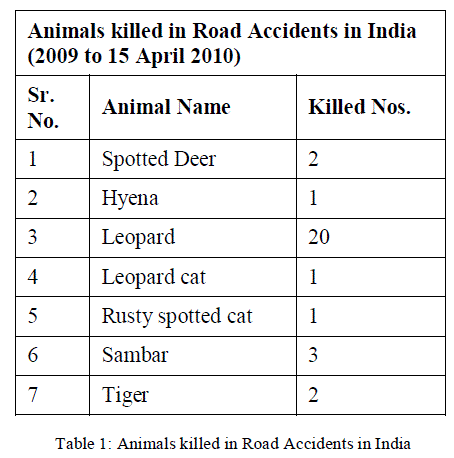 |
| Collisions with animals can have many negative consequences as follows. |
| • Injury to, or death of, vehicle occupants |
| • Loss of valuable livestock or pets |
| • Harm to endangered species |
| • Vehicle damage |
| • Economic losses (cleanup, repairs to vehicles, etc.) |
| • Decrease in enjoyment of a tourist holiday due to frequent road kill encounters. |
| To save the wildlife from a specific accident, a system is presented here to generate the hearing frequency for the specific animal. The animal can alert with the signal of danger and can run away from that place like road, railway track etc. resulting in accident avoidance. |
| Each animal has his own audible range of frequency spectrum and not all kind of animals found everywhere. However, we observed this fact with keen interest and proposed the system which can detect the animal/vehicle and warm them at their audible spectrum. |
| The behavioral response of specific animals to hearing may depend on the type of sound emitted. Pure tones are single frequency and continuous sounds at equal intensity. Complex sounds resemble sounds occurring in nature (i.e., deer vocalizations) [4] and are composed of two or more pure tones of different frequencies that are generated simultaneously and repeated over time. |
| We proposed the system for identification of traffic on road and according to it the animals hearing signals are generated for their irritation due to which the animal run away out of road site. Two PIR sensor are use to analyze the road traffic. If traffic is there on road, the system horns the ultrasonic signals for the specific animals so that the specific animal can ran away. PIR scanning and object recognition using ARM 7, signal generators and power amplifiers for driving the Twitter Horns with specific loudness are used in this work. We surveyed the various hearing frequencies for various animals and particular animal are selected like dogs, cats, bullocks/cows and horses for our work. |
| 1) HEARING RANGES OF ANIMALS |
| The following Table 3 shows the minimum and maximum hearing frequency ranges of the different species. Any attempt to assess the effects of sounds on animals must consider species differences in hearing abilities. Although the hearing ranges of most species overlap to a large degree, considerable variation occurs in high- and lowfrequency hearing as well as in absolute sensitivity. As a result, a sound that is easily audible to one species may be less audible, or even inaudible, to another. |
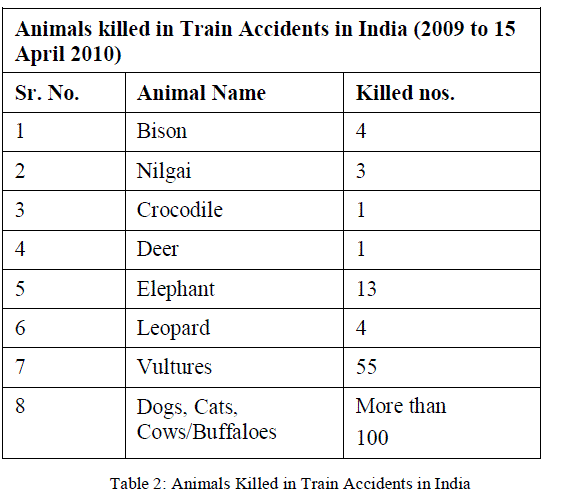 |
| 2) COMMUNICATION BETWEEN ANIMAL SPECIES |
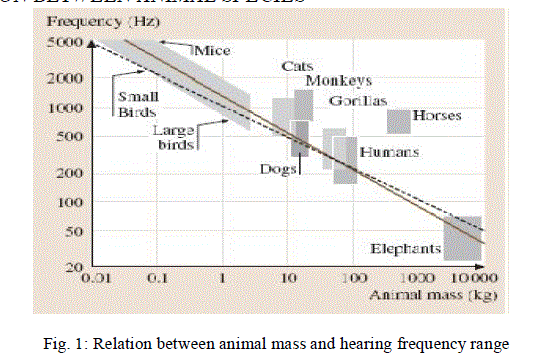 |
| Since animals use their acoustic and vibration senses both to monitor their environment and to communicate with other animals of the same species, we should expect that natural selection has optimized these sensing and sound production abilities. Fig.1. shows the communication between animal species. One particular obvious optimization is to maximize the range over which they can communicate with others of the same species [9]. Simple observation shows that small animals generally use high frequencies for communication while large animals use low frequencies [10-14]. |
| The simplest assumption is that the frequency is determined simply by the physical properties of the sound producing mechanism. For a category of animals differing only in size, the vibration frequency of the sound producing organ depends upon the linear dimensions of the vibrating structure, which are all proportional to the linear size L of the animal, and upon the density ρ and elastic modulus E of the material from which it is made [9- 11]. |
| Elephants represent an interesting extreme animal in the world because of their very large mass as much as 10 tones. Their calls, which have a fundamental in the range 14–35Hz, can have an acoustic power as large as 5W, leading to a detection distance as large as 5 km, or even up to 10 km after sunset on a clear night [9,12]. |
| Some existing system have animal detection and driver alert message system. Some are using sensor based image processing and alert system. Such as Road Animal Detection [RAD], Using RADS [15], animals are detected entering the roadway which automatically triggers the warning device. Drivers are thereby alerted to the presence of animals on the roadway and can react in advance to avoid a potential accident. This system is used in United States of America and Canada now a day. The system is necessary in those countries. In these developed countries, the transportation with long road, highway, bridges and railway lines are constructed. These are made by cutting the forest which directly effect on wild life. So similar system are developed there to save the wild life from the accident held on road, railway crossing, same system are used in US based on the digital image processing by using Embedded System. In this system, there is one camera with embedded kit, the camera capture the animal image which is on the road and give light signal to the vehicle driver. The real view of the similar system is used in United States of America and Canada is shown in Fig.2 and Fig. 3. System consideration are as follows. |
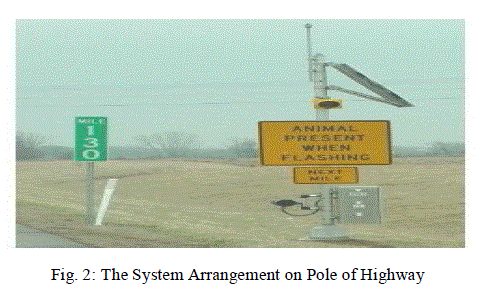 |
III. METHODOLOGY |
| ïÃâ÷ The system is based on the PIR sensor using ARM7 and audio frequency generator to run away the animal. |
| ïÃâ÷ The system used PIR sensor to detect the traffic motion which are travelling along the road. |
| ïÃâ÷ At the same time, the motion can be recognized by the processor and it can generate the ultrasonic signals using audio amplifier. |
| ïÃâ÷ Audio amplifier amplifies the frequency which is irritating to the animal those who come near the road. |
| ïÃâ÷ Due to the audio signal, the animal can ran away from the road and consequently there are minimum chances of accidents. |
| 1) BASIC IDEA |
| Basic idea behind the system is to generate the sound signals which will be inaudible to human and irritating for animals. There irritating frequency can be estimated by specific logic and can be selected and adjusted by trial and error methodology. Irritating frequency generator of a specific loudness is designed in addition with some intelligent operations to sense the traffic of animal/vehicle. Intelligent and energy efficient system is developed with irritating signal generation. Such animal sensing and alert system can be mounted on both side of roads. It will remain un-operative/ideal until any vehicle is detected across the road. |
| 2) BASIC SYSTEM FLOW |
| The proposed system includes PIR sensor and signal processor as a sensing system to detect moving vehicles. The frequency spectrum generator can generate various spectrum of frequencies, As moving vehicle object is detected, the defined frequency signal for the specific list of animal is generated. The specific multiple hearing frequency signal for different animal are generated in the defined multiple frequency spectrums. The generated signal is amplified with power amplifier and is give to the horn buzzer. In this system, the ARM7 processor is used to various hardware for fast and real time response. |
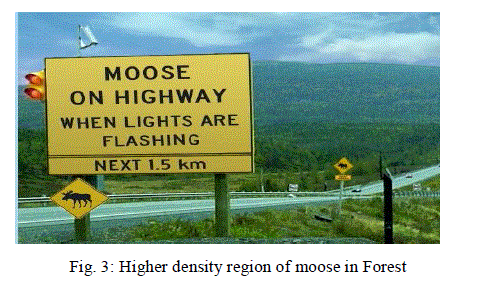 |
| Following are basic element of our system. |
| • Sensor to detect motion |
| • Processor (ARM7) to provide intelligence |
| • Frequency Generator Circuit |
| • Power Amplifier to amplify the signal |
| • Speaker system |
| 2.1) SYSTEM ALGORITHM |
| • Gets real time video from two PIR sensors and ARM processor. |
| • Real time objects tracking/recognition using ARM processor. |
| • If specified objects are recognized by either of the cameras, encode/generate the digital signal equivalent to required stepped ramp signal (using ARM). Duration of the stepped ramp (ramp period) is specified as 3 sec by analysing minimum response period of domestic and wild animals. Stepped ramp is designed according to the generation of audible and irritating frequencies of four animals having maximum occurrence possibility. These four slots of stepped ramp can be increased or decreased as per requirements but initially we designed for four animal’s frequency generation. |
| • Encoded digital signals (which are equivalent to the stepped ramp to be generated) are given to DAC for generating equivalent analog stepped ramp signal. |
| • VCO is the voltage controlled oscillator, which is used to convert stepped ramp signal into the required ultrasonic frequency signals as VCO can be used as a frequency modulator. |
| • Modulated ultrasonic signals are amplified through power amplifier to drive the twitter horn. Twitter horn is selected to provide maximum loudness for particular band of ultrasonic frequencies. |
| • Repeat the Step 1) to 6). |
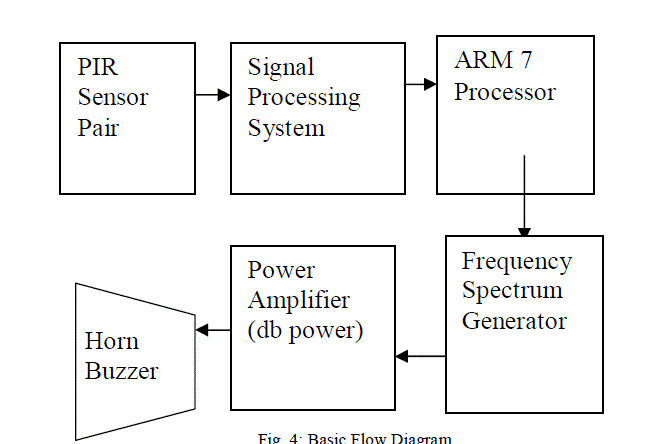 |
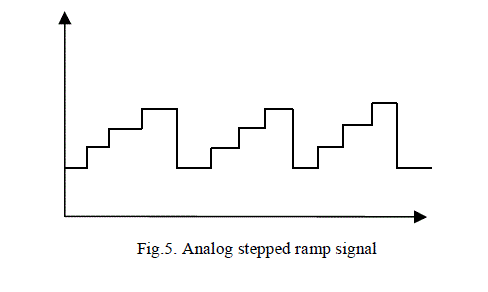 |
| 2.2.2.2) Design of algorithm using ARM processor |
| Algorithm is designed for processing of various tasks using ARM processor and is enlisted as follows. |
| Algorithm: |
| • Initialize all the ports / total system. |
| • Analyse PIR Sensors, if any change found from particular PIR sensor, get the video stream from the corresponding camera, sample out the stream of video and capture sampled frame. |
| • Sampled frame is checked for object and if found, calculate object size (first iteration). |
| • Get next frame, find object, and calculate object size (second iteration). |
| • Get next frame, find object, and calculate object size (third iteration). |
| • Get next frame, find object, and calculate object size (fourth iteration). |
| If within the four iterations, object size is found increasing, generate the sequence codes one by one and repeatedly for the period of three seconds to each. Total duration for code sequence generation is 15 sec required to pass the vehicle across the road. |
| We implemented algorithm in embedded C and audio as well as ultrasonic PWM signals are generated through it and experimentation snapshots are shown in fig.8. |
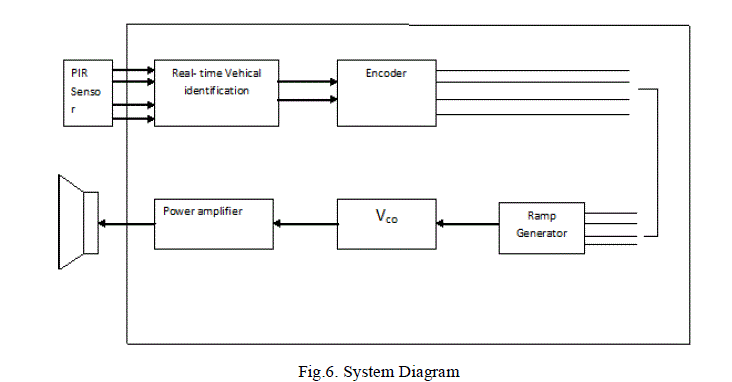 |
| 2.2.2.3) Design of Ramp Generator (DAC) |
| We generated ramp signals using two ways and accuracy is tested for both the ramp generators. 1st ways is using DAC interfaced to ARM processor. As per the programming, analog signal generated are controlled, duration is also controllable using this system. But driver circuit is required to be developed to drive the VCO. Another ramp generator is using buffer and operational amplifiers circuits which is also controllable by processor. Circuit is designed (Fig. 9) and signal are simulated. Only 4 steeped ramp conversions are required to be designed. Here circuit has to design for control of the width and amplitude with specific criteria. Expected ramp is having width of 3 sec and must change its amplitude as per animal’s selection. |
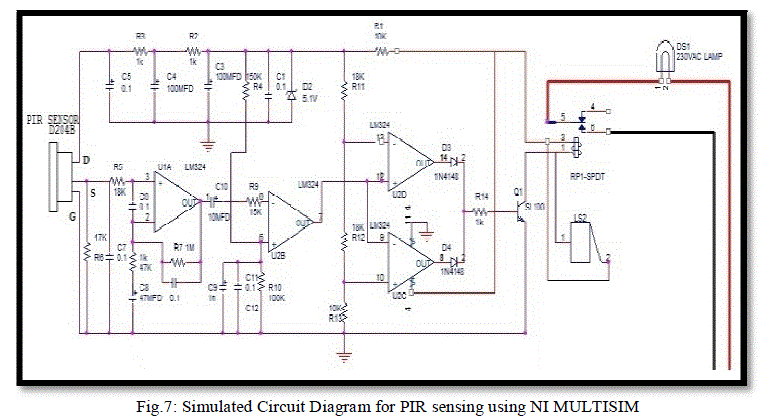 |
| Here stepped ramp is generated as shown in Fig. 10, but it is required to actually generate 4 steps in ramp signal, this will be our next task. |
| 2.2.2.4) Design of VCO circuit |
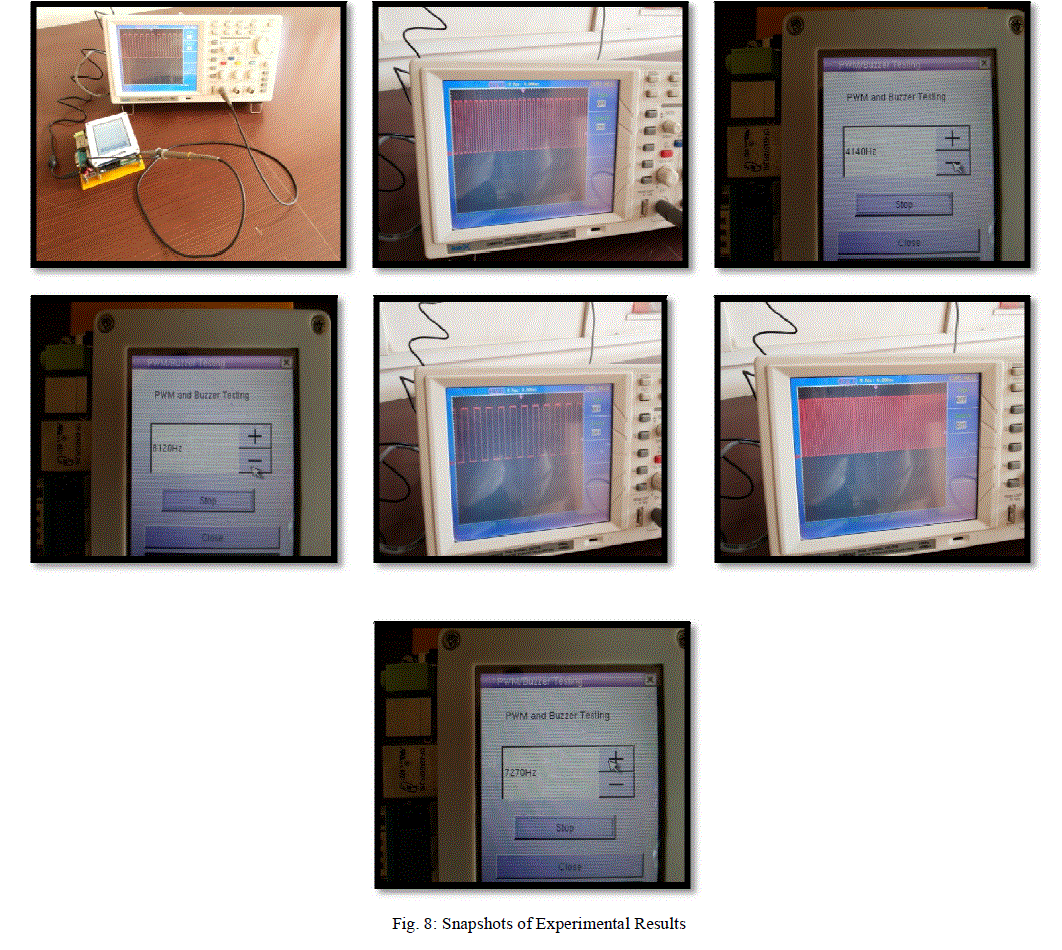 |
| VCO using IC 556 and IC 565 is critical to implement so we decided to use the design using IC 555. Circuit is shown in Fig. 11. According to the input voltage from ramp, generated signal frequency can be controlled. Here central frequency selection is the main task useful for generating the specific variable frequency signal generator using IC 555. |
| Alternate way is to use selectable/controllable/programmable and high frequency signal generator (AD9850 DDS signal Module whose operating frequency is 0-40Mhz) which may work satisfactorily. |
| Using MODELSIM software, system designed is simulated for VCO circuit as shown in Fig. 11. It also includes the simulated results in right side. |
| 2.2.2.5) Power Amplifier |
| Class c Power amplifier is used for amplification purpose designed for specific Ultrasonic twitter. High db loudness and long as well as wide directivity are the requirement of horn system for animal hearing. Twitters are used for high frequency operations so ultrasonic twitters are required to be searched for this work. We selected and purchased 2-3 twitters as per the requirements but specific selection is necessary. According to the selected twitter, power amplifier system can be designed so after actual purchase, it will be designed. We are in process to design the same. |
| 2.2.2.5) System Implemented Setup |
| We collected all the setup material and interfaced according to the connections as per the discussion given above. Camera videos are captured and the object is recognized. We 1st tried to design with animal’s recognition but after experimentation it is decided to design the system using traffic identification of vehicles which is easier because of camera has to direct towards the road sides only in case of traffic identification. This makes to design the combined band of frequencies for expected more than one animal. The system setup are shown in fig.12. |
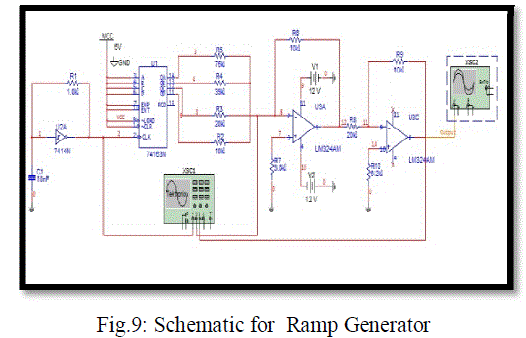 |
CONCLUSION |
| The experimental results are obtained for particular animals like Dog, Cow and Cats. It was successfully tested. It is a new approach in social aspects for wild animal death avoidance and accidents prevention. Animal specific frequency spectrum signals are generated. The specific animal are alerted with these signals of danger and successfully ran away. System can be added on vehicles or trains instead of mounting poles on road side. |
References |
|